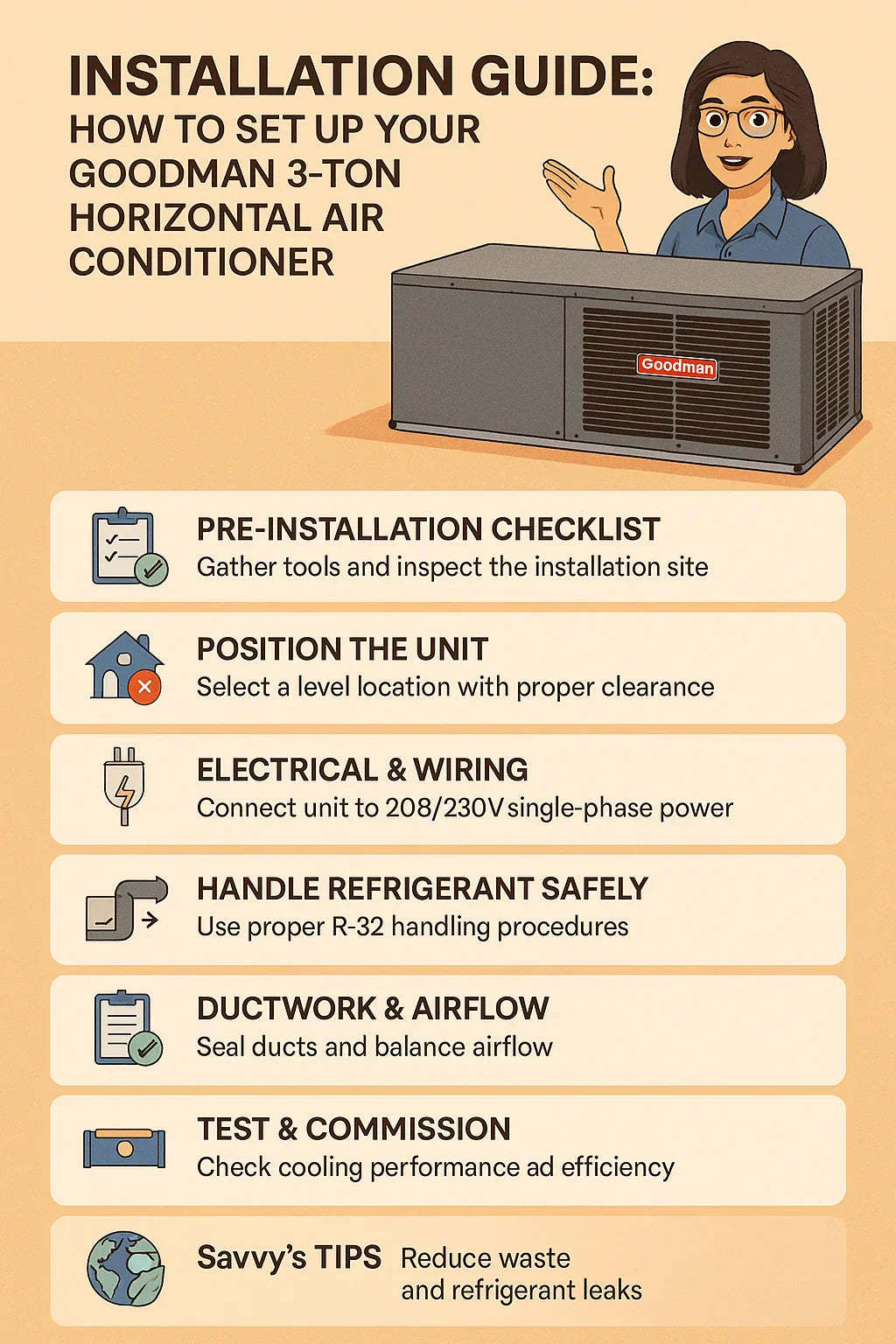Introduction: Why Proper Installation Matters 🌱
Installing an air conditioner is more than just unboxing and plugging it in. Proper installation is critical for energy efficiency, system longevity, and environmental impact — especially when working with modern, eco-friendly units like the Goodman 3-Ton Horizontal Air Conditioner using R-32 refrigerant.
A poorly installed system can:
-
Reduce cooling efficiency
-
Increase energy consumption
-
Shorten equipment lifespan
-
Pose safety hazards
In this guide, we’ll walk you through a step-by-step installation process, covering everything from preparation to commissioning, while keeping Savvy’s eco-conscious mindset in mind. Whether you’re a DIY-savvy homeowner or preparing to supervise a professional, this guide ensures your Goodman system performs efficiently and sustainably from day one.
Step 1: Pre-Installation Checklist 📋
Before touching any tools or electrical connections, it’s crucial to prepare:
Tools & Materials Needed:
-
Screwdrivers, wrenches, and a drill
-
Level and measuring tape
-
HVAC-specific safety equipment (gloves, goggles)
-
Ducting materials and sealant
-
Electrical wiring supplies compatible with 208/230V single-phase power
-
Refrigerant gauges and leak detectors
Site Preparation:
-
Ensure sufficient space for horizontal orientation
-
Check for proper airflow clearance around the unit
-
Inspect the surface for level placement
-
Confirm electrical service is adequate and code-compliant
Savvy Tip:
Always read the manufacturer’s manual first. Following Goodman’s guidelines ensures maximum energy efficiency and prevents voiding the warranty.
External Reference:
Step 2: Positioning Your Horizontal AC Unit 🏡
Horizontal units require careful placement to maximize performance:
1. Choosing the Right Location
-
Ensure adequate clearance on all sides (typically 24–36 inches for airflow)
-
Avoid direct sunlight or heat sources that can overwork the unit
-
Maintain accessibility for maintenance and service
2. Level Placement
-
Use a level to ensure the unit sits evenly
-
Avoid tilting, which can affect compressor function and refrigerant flow
3. Orientation Considerations
-
Horizontal units often have specific left or right airflow options
-
Verify that the duct layout aligns with the manufacturer’s instructions
Savvy Tip:
Eco-conscious placement includes shading the condenser without blocking airflow. A small canopy or landscaping can reduce energy use during heatwaves.
External Reference:
Step 3: Electrical & Wiring Considerations ⚡
Proper electrical setup is critical for safety and efficiency:
1. Power Supply
-
Confirm the unit matches your home’s 208/230V single-phase power
-
Use the correct breaker size and wiring gauge per Goodman guidelines
2. Electrical Connections
-
Always turn off power before connecting
-
Follow color codes and grounding instructions precisely
-
Double-check connections to prevent short circuits
3. Safety First
-
Wear insulated gloves and safety goggles
-
Never bypass safety devices or fuses
Savvy Tip:
For energy efficiency, consider a dedicated AC circuit to prevent voltage drops and improve system performance.
External Reference:
Step 4: Refrigerant Handling & R-32 Safety 🌿
R-32 refrigerant is eco-friendly but requires careful handling:
1. Why R-32 Matters
-
Lower global warming potential (GWP 675)
-
High energy efficiency
-
Future-compliant refrigerant
2. Safety Guidelines
-
R-32 is mildly flammable — avoid sparks, open flames, and smoking
-
Use proper refrigerant gauges and leak detection tools
-
Follow manufacturer protocols for charging and evacuation
3. Environmental Responsibility
-
Minimize leaks during installation
-
Recover or recycle any leftover refrigerant per EPA guidelines
Savvy Tip:
Hiring a certified HVAC professional for refrigerant handling ensures safety and compliance, especially for first-time DIYers.
External Reference:
Step 5: Ductwork & Airflow Optimization 🌬️
Ductwork is crucial for horizontal AC performance:
1. Connecting Supply & Return Ducts
-
Ensure tight connections using foil tape or mastic sealant
-
Avoid sharp bends that restrict airflow
2. Balancing Airflow
-
Properly size ducts to match the 3-Ton capacity
-
Use dampers to control airflow distribution across rooms
3. Inspection & Testing
-
Check for leaks or gaps
-
Verify airflow matches Goodman’s specifications
Savvy Tip:
Eco-conscious homeowners should seal and insulate ducts to reduce energy loss and improve efficiency.
Step 6: Testing & Commissioning ✅
Once installed, it’s time to verify performance:
1. Initial System Check
-
Turn on power and thermostat
-
Listen for unusual noises from the fan or compressor
2. Refrigerant & Pressure Testing
-
Ensure proper refrigerant levels
-
Check for leaks using certified gauges
3. Temperature Verification
-
Measure supply and return air temperatures
-
Confirm SEER2 performance expectations
4. Adjustments
-
Fine-tune fan speeds and thermostat settings for comfort and efficiency
Savvy Tip:
Regular monitoring during the first few days ensures the system runs efficiently, avoiding energy waste.
Step 7: Common Installation Mistakes to Avoid ⚠️
Avoid these pitfalls to ensure optimal performance:
-
Improper leveling, causing refrigerant flow issues
-
Poor clearance around the unit, restricting airflow
-
Electrical mistakes, risking safety and performance
-
Skipping duct sealing, reducing efficiency
Step 8: Savvy’s Eco-Friendly Installation Tips 🌎
-
Minimize Refrigerant Leaks – Handle R-32 responsibly
-
Optimize Unit Placement – Shade condenser without blocking airflow
-
Seal & Insulate Ducts – Reduce energy loss
-
Plan for Maintenance – Ensure easy access for filters and coils
Step 9: Maintenance After Installation 🌱
Proper upkeep after installation ensures long-term efficiency:
-
Clean Filters Monthly – Prevent airflow restrictions
-
Inspect Coils & Drains – Maintain heat transfer efficiency
-
Annual Professional Tune-Ups – Verify refrigerant levels and electrical connections
External Reference:
Conclusion: Efficient and Sustainable Cooling 🌿
Proper installation of your Goodman 3-Ton Horizontal AC ensures:
-
Optimal Performance – Maximum cooling power
-
Energy Efficiency – Lower utility bills
-
Sustainability – Eco-friendly R-32 refrigerant
-
Longevity – Reduced wear and tear
With careful attention to placement, electrical setup, ductwork, and refrigerant handling, your system can deliver reliable, efficient, and environmentally responsible cooling for years to come.
In the next topic we will know more about: The Environmental Benefits of Choosing a Goodman 3-Ton R-32 AC System







